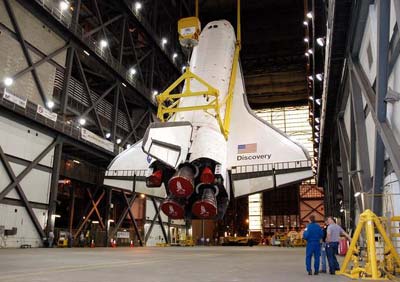Some simple, yet not-so-simple mathby Dwayne A. Day
|
| Everyone at NASA will be feeling greater budgetary pressure as the agency tries to do more with essentially the same amount of money; the shuttle program will feel less pressure than other programs, but the pressure will still be there. |
That is not the only dilemma facing shuttle managers. A recent Government Accountability Office (GAO) report noted that the program will face workforce pressures as it nears shutdown, and these workforce pressures will risk both safety and budget. As the shutdown of a project nears, it is only natural for those who work on it to begin looking for work elsewhere. Nobody wants to be stuck without a chair when the music stops. The GAO report stated that losing skilled workers in the time before the shuttle is retired could create safety problems. One way to retain those workers—and to encourage contracting companies like United Space Alliance to not poach them for other contracts—is to pay them more to stay on the job. But NASA’s budget is already constrained. And if one looks at the famous “sand chart” released in February 2004 depicting the out-year budgets for the agency, you see that NASA is actually planning on spending less on shuttle in its last two years, not more. Certainly some money can be saved by ending contracts for unneeded new equipment like additional solid rocket boosters and external tanks (assuming that NASA does not decide to build a heavy-lift launch vehicle that requires them). It is doubtful, though, that anybody at NASA or the Office of Management and Budget now knows how much can be saved versus how much will be required to encourage workers to not quit the shuttle program.
Another dilemma facing NASA shuttle program managers is one that was implicated in the Columbia accident: “schedule pressure.” As the Columbia Accident Investigation Board reported, NASA Administrator Sean O’Keefe refused to allow slippage in the ISS construction schedule. This forced shuttle managers to cut corners and created a mentality where warning signs—such as a foam impact incident on a shuttle flight before the fatal STS-107 mission—were ignored. In that case the NASA administrator played a role in creating an unsafe flight environment. Now NASA is under new pressure to shut down the shuttle no later than December 31, 2010. But what happens if various launch delays occur between now and then? What if NASA reaches January 1, 2010 and still has seven or eight shuttle flights to fly instead of five? There is little chance that they could all be flown in that remaining time. So at that point (or more likely a year or more earlier) the agency will have to decide either to not fly the remaining missions, or to seek an extension of an extra year or two in the shuttle program. A decision to not fly the remaining missions could itself present additional pressures, as the manifest is shuffled to select only “must-have” payloads.
NASA officials surely are aware of all this, but right now they are primarily focused on getting the shuttle flying again. NASA has barely begun thinking about these things, because they have not had time. The agency will not be able to devote more people to considering the remaining plans for the shuttle until after return to flight, currently scheduled for mid-May.
| Now NASA is under new pressure to shut down the shuttle no later than December 31, 2010. But what happens if various launch delays occur between now and then? What if NASA reaches January 1, 2010 and still has seven or eight shuttle flights to fly instead of five? |
Right now NASA is currently conducting a major reevaluation of the ISS construction schedule and the shuttle flight manifest required to support it. These deliberations are being kept secret for the obvious reason that they will have major budgetary effects on contractors as well as America’s international partners in the space station program. During a recent public hearing, an ISS program manager stated that this effort is intended to produce several different scenarios for finishing the ISS, with the goal of shifting at least some of the remaining equipment to expendable launch vehicles and hopefully reducing the number of shuttle flights to ISS. He also added that NASA will not have a good idea of what kind of launch rate the shuttle can achieve until around summer of 2006.
The official stated that of the 28 remaining flights, roughly five of them are devoted to logistics, five to utilization equipment, and the remaining to basic assembly. However, everything is mixed together. For instance, a major ISS component that fills up the shuttle payload bay may be stuffed with logistics and utilization equipment, the same way that somebody who is moving will put a clothes dresser in a moving van and fill up its drawers with food and dishes from the kitchen. Moving logistical items like food and water off of the shuttle and onto foreign or private rockets may not save any flights at all, because it is the big components that drive the requirements. Only by eliminating major ISS hardware—most of which cannot be launched on expendable vehicles because they were not designed for them—can the number of shuttle missions be reduced.
What all of this means is that although NASA will return the shuttle to flight with a better understanding of the physical and cultural and management threats to safety, the schedule, budget, and management pressures will all increase on the program, probably dramatically so by the end of this decade. The shuttle program is going to be entering dangerous times. It will be up to NASA’s new Engineering and Safety Center to be vigilant as the peril grows.
